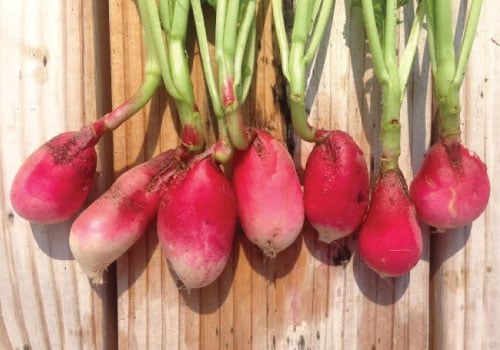
Learning Download: How to Grow Radishes
From Seed to Harvest: A guide to growing radishes.
Radishes are the perfect vegetable for new gardeners, as the roots are ready to harvest in as little as 21 days. Radishes can be eaten raw or added to salads for an extra crunch with a bit of flavor. Although oftentimes the tops are composted, radish greens also can be eaten by sautéing them in a pan or adding raw greens with the radishes to a salad.
To plant:
Radishes do best when sown directly into the garden, as they are a cool-weather crop and can be grown in the spring and fall. As soon as the soil can be worked, plant the radish seeds in a spot in the garden that receives full sun. This is usually about four to six weeks before the last frost date. Prior to planting, till the soil 8 inches deep as radishes grow below ground. Remove any rocks or debris in the radish bed as this can inhibit growth.
Once the area has been tilled and cleared, plant the seeds 1/2 inch deep and 3 inches apart in furrows. Cover loosely with soil. Continue to plant radish seeds every two weeks while the weather is cool for a continuous harvest. Add a floating row cover to prevent maggots and flea beetles from attacking the seedlings.
To grow:
Radishes grow best in soil with a pH of 5.8 to 6.8. When radishes are 2 inches in height, thin them to 3 inches apart. Only grow radishes in the spring and fall because if grown in warmer months they will bolt, creating a bitter flavor with a woody texture in the roots. Radishes grown in cooler temperatures have a milder flavor. If warmer weather is a danger to a gardener’s radishes, mulching and consistent watering can delay the effects of bolting. When planted near cucumbers, peppers and squash, radishes can draw aphids away form the other plants.
To harvest:
Radishes are ready to harvest when the leaves are 4 inches tall. Red radishes are ready to harvest when the roots are approximately 1 inch in diameter. White radishes are ready to harvest when the roots are 3/4 inch in diameter. To harvest, pull the entire plant straight up from the soil.
What radishes crave:
Since radishes grow so fast, they don’t need fertilized during their growth but can benefit from soil that is fertilized prior to planting the seeds. Before planting, spread a 2-inch layer of compost over the furrows where the radish seeds will grow. Sprinkle 1/2 pound of 16-20-0 fertilizer per 50 square feet of radishes. Mix the compost-fertilizer blend into the top 6 inches of soil. Avoid fertilizers high in nitrogen. Instead of fertilizing after planting the radishes, spread mulch enriched with wood ash around the plants.
Where to buy radish seeds:
you can find many kids of radish seeds with colors ranging from the traditional red to a unique watermelon variety at Urban Farmer.
Learning Download: Common pests and diseases: Radishes
Common pests and diseases: Radishes
When growing vegetables, it is always exciting to care for the plant throughout its growing phase and then harvest it for delicious recipes later on, but one thing to watch out for is pests and diseases. Different plants are susceptible to different types of pests and diseases, and it is important to make yourself aware so you can keep a watchful eye and also take any preventative methods to keep your plants safe throughout their lifespan.
Radishes can fall victim to several different pests and diseases.
Pests:
Some of the most common pests attacking radishes include aphids, cutworms and cabbage loopers. Typically, the pests only affect the radish’s foliage since the radish is grown underground, but it is still very important to control any infestations. Since radish greens can also be consumed, it’s important to keep them healthy.
Aphids are soft-bodied insects that bring problems to lots of plants. They create discoloration of the leaves, necrotic spots and stunted growth. Use tolerant varieties and only apply insecticides if there’s a high infestation.
Armyworms will cause closely grouped holes in the foliage, and heavy feeding can cause leaves to become skeletonized. You may see egg clusters on the leaves. To organically control armyworms, encourage natural enemies or apply Bacillus thuringiensis.
Cabbage loopers will leave large holes in the leaves and can cause lots of damage. Eggs are typically laid i singularly. To control cabbage loopers, encourage natural enemies. You can handpick them from the plants, or apply Bacillus thuringiensis to kill the larvae. Stay away from chemical sprays which might harm natural predators.
Diseases:
Some common diseases affecting radishes include Alternaria blight, clubroot, downy mildew, white rust and more.
Alternaria blight will cause dark or yellow spots on leaves, stems or the flowers of the radish. The lesion’s center may dry out. This is a fungus that prefers warm, wet weather. To manage, only plant disease-free seed, treat seeds with hot water prior to planting, rotate crops and irrigate plants in the morning.
Clubroot causes slow growing or stunted plants with leaves that yellow during the day, wilt during the day and then become rejuvenated at night. To prevent this from happening, plant only disease-free seed and apply lime to the soil.
Downy mildew causes lesions on the upper surface of the leaves and a white growth on the bottom of the leaves. It favors cool, damp weather. To prevent this, remove all crop debris and rotate crops.
White rust causes white pustules on leaves, stems and flowers which grow as the infection spreads. Leaves may roll and become thick. The disease is spread by the wind. To prevent this disease, plant only disease-free seed and apply fungicides if needed.
Learning Download: Radish Comparison Chart
Radish Comparison Chart
| Variety | Shape | Days to Maturity | Color | Flavor |
| Black Spanish Round | Round | 60 | Black | Nutty and slightly spicy |
| Butter Globe | Round | 35 | Red | Mild and juicy |
| Champion | Round | 28 | Red | Crisp and tender |
| Cherry Belle | Round | 22 | Pink | Crunchy and zesty |
| China Rose | Long | 55 | Pink | Peppery |
| Confetti Mix | Round | 25 | Red and white | Mild and juicy |
| Crayon Colors Mix | Round | 32 | Pink, purple, red, white and yellow | Crisp and juicy |
| Crimson | Round | 29 | Red | Crisp and zesty |
| Early Scarlet Globe | Round | 24 | Red | Mild and tender |
| Easter Egg | Round | 25 | Pink, purple, red and bi-colored | Crunchy and juicy |
| Fiesta Blend | Round | 35 | Pink, purple, red, white and yellow | Crisp and zesty |
| French Breakfast | Oblong | 25 | Red tops with white tips | Crunchy and delicate |
| Golden Helios | Round | 35 | Yellow | Sweet and mild |
| Hailstone | Round | 25 | White | Crisp and juicy |
| Halloween Mix | Round | 33 | Black, purple, white and yellow | Mildly spicy |
| Long Scarlet Cincinnati | Long | 25-30 | Red | Super sweet and tender |
| Minowase Daikon | Round | 65 | White | Crisp and mild |
| Purple Plum | Round | 25 | Purple | Mild and sweet |
| Rudolph | Round | 24 | Red | Crunchy and pungent |
| Sparkler | Round | 32 | Red and white bi-colored | Sweet and snappy |
| Watermelon | Round | 55 | White with pink on the inside | Crisp and sweet |
| White Icicle | Long | 29 | White | Mild and zesty |


